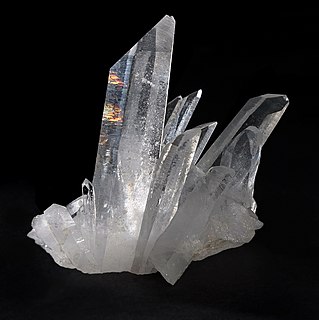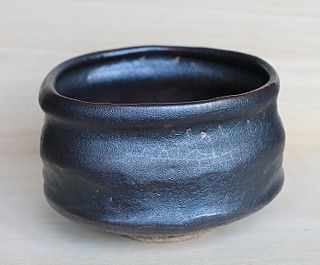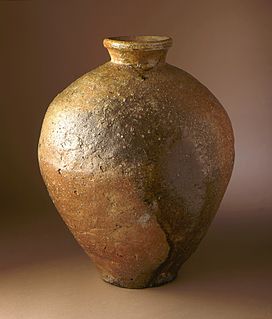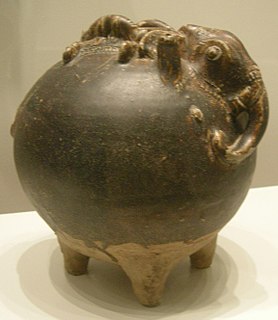History
Ceramics were first uncovered in 1970 at a construction site at kilometer 3, Thadeua Road in the Vientiane area of the Mekong Valley. Construction was halted only temporarily, and the kiln was hastily and unprofessionally excavated over a one-month period. At least four more kilns have been identified since then, and surface evidence and topography indicate at least one hundred more in the Ban Tao Hai (Village of the Jar Kilns) vicinity. Archaeologists have labeled the area Sisattanak Kiln Site.

Vientiane is the capital and largest city of Laos, on the banks of the Mekong River near the border with Thailand. Vientiane became the capital in 1563 due to fears of a Burmese invasion but was later looted then razed to the ground in 1827 by the Siamese (Thai). Vientiane was the administrative capital during French rule and, due to economic growth in recent times, is now the economic center of Laos. The city had a population of 820,000 as at the 2015 Census.

A kiln is a thermally insulated chamber, a type of oven, that produces temperatures sufficient to complete some process, such as hardening, drying, or chemical changes. Kilns have been used for millennia to turn objects made from clay into pottery, tiles and bricks. Various industries use rotary kilns for pyroprocessing—to calcinate ores, to calcinate limestone to lime for cement, and to transform many other materials.
According to Honda and Shimozu (The Beauty of Fired Clay: Ceramics from Burma, Cambodia, Laos, and Thailand, 1997), the Lao kilns are similar to the Siamese types found at Suphanburi and Si Satchanalai. But Hein, Barbetti and Sayavongkhamdy (An Excavation at the Sisattanak Kiln Site, Vientiane, Lao P.D.R., 1989, 1992) say that the Lao kilns, which are of a cross-draft clay-slab type, differ substantially not only from the Siamese types but all other types in Southeast Asia.

Cambodia, officially the Kingdom of Cambodia, is a country located in the southern portion of the Indochina peninsula in Southeast Asia. It is 181,035 square kilometres in area, bordered by Thailand to the northwest, Laos to the northeast, Vietnam to the east and the Gulf of Thailand to the southwest.

Laos, officially the Lao People's Democratic Republic, commonly referred to by its colloquial name of Muang Lao, is a socialist state and the only landlocked country in Southeast Asia. Located at the heart of the Indochinese peninsula, Laos is bordered by Myanmar (Burma) and China to the northwest, Vietnam to the east, Cambodia to the southwest, and Thailand to the west and southwest.

Thailand, officially the Kingdom of Thailand and formerly known as Siam, is a country at the centre of the Southeast Asian Indochinese peninsula composed of 76 provinces. At 513,120 km2 (198,120 sq mi) and over 68 million people, Thailand is the world's 50th largest country by total area and the 21st-most-populous country. The capital and largest city is Bangkok, a special administrative area. Thailand is bordered to the north by Myanmar and Laos, to the east by Laos and Cambodia, to the south by the Gulf of Thailand and Malaysia, and to the west by the Andaman Sea and the southern extremity of Myanmar. Its maritime boundaries include Vietnam in the Gulf of Thailand to the southeast, and Indonesia and India on the Andaman Sea to the southwest. Although nominally a constitutional monarchy and parliamentary democracy, the most recent coup in 2014 established a de facto military dictatorship.
Because only one kiln, VS8, has been excavated, almost no questions regarding Lao ceramic tradition have been answered. The VS8 kiln though showed no evidence of brick construction. It had square chimney foundations, a narrow firebox, and was built partly above ground.
The Sisattanak Kiln Site lies just outside Vientiane's first city walls, which are dated to the 15th century. Radiocarbon dating of the kiln gives a 15th-17th century timeframe, with an earlier period of that range most likely. This is supported by the evidence of surface finds, which suggest that area kilns at higher elevations show a greater ratio of glazed to unglazed wares. The theory is that the kilns were moved up over time and that more glazed wares were fired over time. This is supported by the ceramics uncovered at VS8, a lower-elevation site, which were all of a utilitarian and domestic nature. They included pipes, domestic wares and architectural fittings.
The VS8 excavation uncovered both unglazed and glazed wares. Most of the glazed wares were pipes; 1,500 pipe fragments and complete pieces were collected. Their quality indicates a well-developed tradition, and their motifs suggest the possibility that they were export wares.
From the examples collected to date, it can be said that Lao ceramics used one kind of clay, with 5% quartz added as a temper. Both the clay and the quartz were finely crushed. The glazed wares were a light, translucent green (like celadon) or various shades of brown. There have also been shards showing an olive-colored glaze, not unlike the type found in Thailand.

Quartz is a mineral composed of silicon and oxygen atoms in a continuous framework of SiO4 silicon–oxygen tetrahedra, with each oxygen being shared between two tetrahedra, giving an overall chemical formula of SiO2. Quartz is the second most abundant mineral in Earth's continental crust, behind feldspar.

Celadon is a term for pottery denoting both wares glazed in the jade green celadon color, also known as greenware and a type of transparent glaze, often with small cracks, that was first used on greenware, but later used on other porcelains. Celadon originated in China, though the term is purely European, and notable kilns such as the Longquan kiln in Zhejiang province are renowned for their celadon glazes. Celadon production later spread to other regions in Asia, such as Japan, Korea and Thailand. Eventually, European potteries produced some pieces, but it was never a major element there. Finer pieces are in porcelain, but both the color and the glaze can be produced in stoneware and earthenware. Most of the earlier Longquan celadon is on the border of stoneware and porcelain, meeting the Chinese but not the European definitions of porcelain.
Many of the glazed wares have ribbed or fluted exteriors, similar to that of the silver bowls ubiquitous in Laos, both the regular silver bowls ("oh tum") and the silver stem bowls ("khan"). Glazed ceramic stem bowls have been collected as surface finds at the Sisattanak Kiln Site. Decorations to glazed wares show a great measure of restraint, with simple incisions, stamps and fluting. Unglazed wares are similarly austere. They are generally not decorated with incisions or stamps, which are common in other Southeast Asian wares.
The VS8 excavation in 1989 added to an ever-increasing body of evidence that Lao ceramic tradition is significant. Future excavations are expected to prove that Lao ceramic production was comparable to that of other countries in the region.

Raku ware is a type of Japanese pottery traditionally used in Japanese tea ceremonies, most often in the form of chawan tea bowls. It is traditionally characterised by being hand-shaped rather than thrown, fairly porous vessels, which result from low firing temperatures, lead glazes and the removal of pieces from the kiln while still glowing hot. In the traditional Japanese process, the fired raku piece is removed from the hot kiln and is allowed to cool in the open air. The familiar technique of placing the ware in a container filled with combustible material is not a traditional Raku practice.

Porcelain is a ceramic material made by heating materials, generally including kaolin, in a kiln to temperatures between 1,200 and 1,400 °C. The toughness, strength, and translucence of porcelain, relative to other types of pottery, arises mainly from vitrification and the formation of the mineral mullite within the body at these high temperatures. Though definitions vary, porcelain can be divided into three main categories: hard-paste, soft-paste and bone china. The category that an object belongs to depends on the composition of the paste used to make the body of the porcelain object and the firing conditions.

Longquan celadon (龍泉青瓷) is a type of green-glazed Chinese ceramic, known in the West as celadon or greenware, produced from about 950 to 1550. The kilns were mostly located in Lishui prefecture in southwestern Zhejiang Province in the south of China, and the north of Fujian Province. Overall a total of some 500 kilns have been discovered, making the Longquan celadon production area one of the largest historical ceramic producing areas in China. "Longquan-type" is increasingly preferred as a term, in recognition of this diversity, or simply "southern celadon", as there was also a large number of kilns in north China producing Yaozhou ware or other Northern Celadon wares. These are similar in many respects, but with significant differences to Longquan-type celadon, and their production rose and declined somewhat earlier.

Earthenware is glazed or unglazed nonvitreous pottery that has normally been fired below 1200°C. Porcelain, bone china and stoneware, all fired at high enough temperatures to vitrify, are the main other important types of pottery.

Stoneware is a rather broad term for pottery or other ceramics fired at a relatively high temperature. A modern technical definition is a vitreous or semi-vitreous ceramic made primarily from stoneware clay or non-refractory fire clay. Whether vitrified or not, it is nonporous ; it may or may not be glazed. Historically, across the world, it has been developed after earthenware and before porcelain, and has often been used for high-quality as well as utilitarian wares.

Pottery and porcelain , is one of the oldest Japanese crafts and art forms, dating back to the Neolithic period. Kilns have produced earthenware, pottery, stoneware, glazed pottery, glazed stoneware, porcelain, and blue-and-white ware. Japan has an exceptionally long and successful history of ceramic production. Earthenwares were created as early as the Jōmon period, giving Japan one of the oldest ceramic traditions in the world. Japan is further distinguished by the unusual esteem that ceramics holds within its artistic tradition, owing to the enduring popularity of the tea ceremony.

Korean ceramic history begins with the oldest earthenware dating to around 8000 BC. Influenced by Chinese ceramics, Korean pottery developed a distinct style of its own, with its own shapes, such as the moon jar or maebyeong version of the Chinese meiping vase, and later styles of painted decoration. Korean ceramic trends had an influence on Japanese pottery and porcelain. Examples of classic Korean wares are the celadons of the Goryeo dynasty (918–1392) and the white porcelains of the Joseon dynasty (1392–1897).

Medieval Islamic pottery occupied a geographical position between Chinese ceramics, then the unchallenged leaders of Eurasian production, and the pottery of the Byzantine Empire and Europe. For most of the period it can fairly be said to have been between the two in terms of aesthetic achievement and influence as well, borrowing from China and exporting to and influencing Byzantium and Europe. The use of drinking and eating vessels in gold and silver, the ideal in ancient Rome and Persia as well as medieval Christian societies, is prohibited by the Hadiths, with the result that pottery and glass were used for tableware by Muslim elites, as pottery also was in China, but was much rarer in Europe and Byzantium. In the same way Islamic restrictions greatly discouraged figurative wall-painting, encouraging the architectural use of schemes of decorative and often geometrically-patterned tiles, which are the most distinctive and original speciality of Islamic ceramics.

Oribe ware is a style of Japanese pottery that first appeared in the sixteenth century. Modern artists specializing in Oribe ware include Yasuo Tamaoki and Osamu Suzuki, who was designated a Living National Treasure in 1994. Suzuki Goro is a modern artist who works in Oribe ware amongst others, as well as Shigeru Koyama. The Museum of Furuta Oribe in Kyoto opened in 2014 and exhibits a number of Oribe wares.

Shigaraki ware (信楽焼) is a type of stoneware pottery made in Shigaraki area, Japan. The kiln is one of the Six Ancient Kilns in Japan. Although figures representing the Tanuki are a popular product included as Shigaraki ware, the kiln and local pottery tradition has a long history.

Chinese ceramics show a continuous development since pre-dynastic times and are one of the most significant forms of Chinese art and ceramics globally. The first pottery was made during the Palaeolithic era. Chinese ceramics range from construction materials such as bricks and tiles, to hand-built pottery vessels fired in bonfires or kilns, to the sophisticated Chinese porcelain wares made for the imperial court and for export. Porcelain was a Chinese invention and is so identified with China that it is still called "china" in everyday English usage.
Vietnamese ceramics refers to ceramic art and pottery as a form of Vietnamese art. Vietnamese pottery and ceramics has a long history spanning back to thousands of years ago, including long before Chinese domination, as archeological evidence supports.

Jun ware is a type of Chinese pottery, one of the Five Great Kilns of Song dynasty ceramics. Despite its fame, much about Jun ware remains unclear, and the subject of arguments among experts. Several different types of pottery are covered by the term, produced over several centuries and in several places, during the Northern Song dynasty (960–1126), Jin dynasty (1115–1234) and Yuan dynasty (1271–1368), and lasting into the early Ming dynasty.

Dehua porcelain, more traditionally known in the West as Blanc de Chine, is a type of white Chinese porcelain, made at Dehua in the Fujian province. It has been produced from the Ming dynasty (1368–1644) to the present day. Large quantities arrived in Europe as Chinese export porcelain in the early 18th century and it was copied at Meissen and elsewhere. It was also exported to Japan in large quantities.

Jian ware or Chien ware is a type of Chinese pottery originally made in Jianyang, Fujian province. It, and local imitations of it, is known in Japan as Tenmoku (天目). The wares are simple shapes in stoneware, with a strong emphasis on subtle effects in the glazes. In the Song dynasty they achieved a high prestige, especially among Buddhist monks and in relation to tea-drinking. They were also highly valued in Japan, where many of the best examples were collected. Though the ceramic body is light-coloured, the wares, generally small cups for tea, bowls and vases, normally are glazed in dark colours, with special effects such as the "hare's fur" "oil-spot" and "partridge feather" patterns caused randomly as excess iron in the glaze is forced out during firing.
























